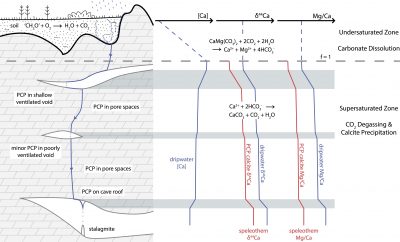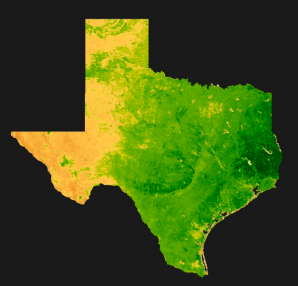Background
Study Details
Speleothem carbonates have commonly been evaluated as excellent terrestrial paleoclimatic indicators. This project seeks to develop a method to determine trace elemental/calcium (TE/Ca) ratios in dripwater and calcite plates as a way to quantitatively determine the extent to which various epikarst and in-cave processes control fractionation in central Texas caves. Solution-based ICP-MS will be used to obtain Sr/Ca, Ba/Ca, and Mg/Ca ratios to tell a story of dripwater evolution over time, from its infiltration into epikarst soils to the eventual precipitation of calcite and formation of speleothems.

This project hopes to evaluate the extent to which these ratios can be used to quantify prior calcite precipitation (PCP), aridity, and effective precipitation, as well as visualize relationships between in-cave parameters and resulting water chemistry differences between rainfall, dripwaters, and speleothems. This new method should provide the ability to better study large-scale aridity changes in modern and future climates, and provide invaluable insight in improving predictions regarding future water quantity changes along the 100th Meridian and in Central Texas.
Major John Wesley Powell first introduced the concept of the 100th Meridian as an aridity gradient in 1879 in a report to the United States Congress. In this statement, he described a transition from the moist southeastern climate to an arid western desert that occurred along this margin (Powell, 1879).

Since then, climate change has driven this boundary to the east with temperature increase, and Seager et al. (2018) suggests that this will continue. Speleothem records in Central Texas have recorded similar warming events and their relationship with more polarized precipitation along the 100th Meridian (Miller et al, 2021). Until Miller’s recent study, speleothems seldom produced resolution on annual or seasonal timescales. However, after discovering the likely seasonal banding evident in CLFM imagery, we considered that water chemistry changes due to geologic processes could be the cause of these seasonal changes.
Characterizing elemental concentrations in cave dripwater and associated farmed calcite in Central Texas should improve our understanding of soil moisture and effective precipitation in the region. By developing a method to evaluate TE/Ca ratios, this project seeks to evaluate the relative extent to which various epikarst and in-cave processes cause the seasonal banding observed in the speleothem record (Miller et al, 2021). Similar studies have proven that trace element analysis by Q-ICP-MS can produce data with excellent signal to noise ratios much more quickly and cost-effectively than alternative methods such as sector field ICP-MS, TIMS, and ICP-AES (Owen et al., 2016; Yu et al., 2006).
Relevant Previous Work
Wong et al 2011 discusses the idea that TE/Ca variations in dripwater can be controlled by multiple different mechanisms, including cave ventilation (related to CO2 partial pressure), bedrock composition, temperature, and growth rate (Wong et al 2011). Miller et al. (2021) visualized the seasonal banding in speleothems that can occur due to these changes in dripwater chemistry and fractionation. Based on these two prior studies, we developed two distinct methods of measuring TE/Ca ratios: one for dripwaters and one for plate calcite. These methods were adapted from the previous studies discussed below.
In previous studies, a double-dilution method was used to measure trace elements and calcium. Our dripwater method eliminates any error or correction between the two modes by measuring all analytes in one run. This method was adapted from Casteel and Banner, 2014.
A similar double-dilution method has been used to measure TE/Ca ratios in calcite, where trace elements are measured in one dilution and calcium is measured in the other. Rosenthal et al, 1999 and Day and Henderson, 2013 used a “ratio” method in sector field analysis, where ratios were measured directly by assigning a known calcium concentration to the unknowns. We adapted this method to assign stoichiometric calcium concentration to each unknown on a quadrupole ICP-MS, allowing us to measure TE/Ca ratios directly. This permits a faster analysis and less required sample volume. Samples are typically extremely limited due to slow drip durations and drought conditions, which can severely reduce drip amount or completely stop it. The goal of our methods project is to increase precision and accuracy for dripwater and plate calcite TE/Ca ratios while reducing the amount of sample needed.